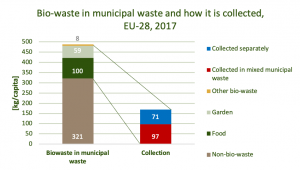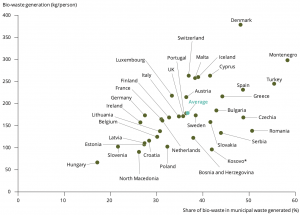Biowaste
Biowaste, bio-waste or biodegradable waste is a type of feedstock defined as waste from organic origin. It includes any organic matter in waste which can be broken down into carbon dioxide, water, methane or simple organic molecules (biodegradability) by micro-organisms and other living things by composting, aerobic digestion, anaerobic digestion or similar processes. It also includes some inorganic materials which can be decomposed by bacteria.
Tech4Biowaste follows the following definition:
Bio-waste is defined as biodegradable garden and park waste, food and kitchen waste from households, restaurants, caterers and retail premises, and comparable waste from food processing plants. It does not include forestry or agricultural residues, manure, sewage sludge, or other biodegradable waste such as natural textiles, paper or processed wood. It also excludes those by-products of food production that never become waste.[1]
Types of biowaste
Bio-waste is defined as biodegradable garden and park waste and food waste from kitchens households, restaurants, caterers and retail premises, as well was comparable waste from food processing plants. It does not include forestry or agricultural residues, manure, sewage sludge, or other biodegradable waste such as natural textiles, paper or processed wood. It also excludes those by-products of food production that never become waste[1]. Depending on its origin the biowaste may occur in relatively pure fractions or in form of municipal waste (different contents of biogenic wastes mixed with other non-biogenic fractions that are out of scope within of the Tech4Biowaste database).

Composition of biowaste
In Europe, biowaste is mainly composed of food waste (59.9%), followed by garden waste (35.3%), and other bio-waste (4.8%).
| Area | Food waste [%] | Garden waste [%] | Other bio-waste [%] |
|---|---|---|---|
| EU-28 | 59.9 | 35.3 | 4.8 |
| Belgium | 30.5 | 51.7 | 17.8 |
| Bosnia and Herzegovina | 89.4 | 6.5 | 4.1 |
| Bulgaria | 56.8 | 43.2 | - |
| Croatia | 73.5 | 24.8 | 1.7 |
| Cyprus | 71.4 | 28.6 | - |
| Czechia | 34.8 | 60.9 | 4.3 |
| Denmark | 92.7 | 7.3 | - |
| Estonia | 84.5 | 12.0 | 3.5 |
| Finland | 76.1 | 10.1 | 13.8 |
| France | 42.6 | 50.0 | 7.4 |
| Germany | 52.3 | 47.7 | - |
| Greece | 93.2 | 6.9 | - |
| Hungary | 21.9 | 54.2 | 24.0 |
| Iceland | 87.5 | 11.6 | 0.9 |
| Ireland | 79.2 | 16.5 | 4.3 |
| Italy | 68.4 | 25.5 | 6.2 |
| Kosovo | 95.0 | 5.0 | - |
| Lativa | 60.0 | 17.4 | 22.7 |
| Lithuania | 35.8 | 39.2 | 25.1 |
| Luxembourg | 62.9 | 37.1 | - |
| Malta | 95.7 | 4.3 | - |
| Netherlands | 64.0 | 8.0 | 28.0 |
| Poland | 64.0 | 36.0 | - |
| Portugal | 74.8 | 21.6 | 3.7 |
| Romania | 66.7 | 33.3 | - |
| Serbia | 59.6 | 28.1 | 12.3 |
| Slovakia | 52.5 | 47.5 | - |
| Slovenia | 59.4 | 37.2 | 3.5 |
| Spain | 82.2 | 17.8 | - |
| Sweden | 80.7 | 19.3 | - |
| Switzerland | 47.0 | 53.0 | - |
| United Kingdom | 47.7 | 45.9 | 6.4 |
Capture rate
| Area | Capture rate [%] |
|---|---|
| Austria | 86.782 |
| Slovenia | 80.503 |
| Belgium | 65.955 |
| Germany | 64.486 |
| Switzerland | 58.879 |
| Sweden | 58.344 |
| Italy | 57.815 |
| Luxembourg | 55.808 |
| Netherlands | 53.805 |
| Czechia | 50.2 |
| Denmark | 50.196 |
| Average | 50.2 |
| France | 50.2 |
| United Kingdom | 47.397 |
| Finland | 40.316 |
| Hungary | 35.514 |
| Ireland | 33.778 |
| Estonia | 28.972 |
| Poland | 27.236 |
| Lithuania | 26.302 |
| Lativa | 23.364 |
| Slovakia | 22.029 |
| Bulgaria | 18.158 |
| Iceland | 14.953 |
| Croatia | 14.816 |
| Romania | 13.351 |
| Portugal | 9.079 |
| Turkey | 8.545 |
| Spain | 8.011 |
| Greece | 6.409 |
| Bosnia and Herzegovina | 6.409 |
| Cyprus | 4.272 |
| North Macedonia | - |
List of Wastes (LoW) codes
In the EWC-Stat Waste Categories biowaste is included in item 31 ("Animal and mixed food waste"), item 32 ("Vegetal wastes") and partly item 34 ("Household and similar wastes").[3]
Animal and mixed food waste[3]
- Animal waste of food preparation and products
- Animal-tissue waste (02 01 02)
- Sludges from washing and cleaning (02 02 01)
- Animal-tissue (02 02 02)
- Materials unsuitable for consumption or processing (02 02 03)
- Materials unsuitable for consumption or processing (02 05 01)
- Mixed waste of food preparation and products
- Wastes from preserving agents (02 03 02)
- Wastes from preserving agents (02 06 02)
- Grease and oil mixture from oil/water separation containing only edible oil and fats (19 08 09)
- Biodegradable kitchen and canteen waste (20 01 08)
- Edible oil and fat (20 01 25)
Vegetal wastes[3]
- Green wastes
- Wastes from forestry (02 01 07)
- Biodegradable waste (20 02 01)
- Vegetal waste of food preparation and products
- Sludges from washing and cleaning (02 01 01)
- Plant-tissue waste (02 01 03)
- Sludges from washing, cleaning, peeling, centrifuging and separation (02 03 01)
- Wastes from solvent extraction (02 03 03)
- Materials unsuitable for consumption or processing (02 03 04)
- Materials unsuitable for consumption or processing (02 06 01)
- Wastes from washing, cleaning and mechanical reduction of raw materials (02 07 01)
- Wastes from spirits distillation (02 07 02)
- Materials unsuitable for consumption or processing (02 07 04)
Household and similar wastes[3]
- Household wastes
- Mixed municipal waste (20 03 01)
- Waste from markets (20 03 02)
- Bulky waste (20 03 07)
- Municipal wastes not otherwise specified (20 03 99)
- Street cleaning wastes
- Street-cleaning residues (20 03 03)
Additional information
Currently the main environmental threat from biowaste (and other biodegradable waste) is the production of methane from such waste decomposing in landfills, which accounted for some 3% of total greenhouse gas emissions in the EU-15 in 1995. The Landfill Directive (1999/31/EC)[4] obliges Member States to reduce the amount of biodegradable municipal waste that they landfill to 35% of 1995 levels by 2016 (for some countries by 2020) which will significantly reduce this problem.[5]
According to the European Compost Network (ECN), across the European Union, somewhere between 118 and 138 million tons of bio-waste arise annually, of which currently only about 40% (equivalent to 47,5 million tons per annum [M tpa]) is effectively recycled into high-quality compost and digestate. As up to 50% of municipal solid waste is organic, the bio-waste fraction plays an important role in recycling and the nascent circular economy. Implementation of separate collection of bio-waste in all EU member states as laid down in the Waste Framework Directive is a key for diverting organic waste from landfills and to guarantee that high-quality secondary raw materials (composts and digestate) are consistently manufactured, so that they can be placed on the European fertilizer market.[6]
References
- ↑ a b European Commission, : Biodegradable waste , Last access 2021-09-23. https://ec.europa.eu/environment/topics/waste-and-recycling/biodegradable-waste_en
- ↑ a b c European Environment Agency (EEA), 2020: Bio-waste in Europe — turning challenges into opportunities. European Environment Agency, Copenhagen, Denmark.
- ↑ a b c d EUROSTAT, 2010: Guidance on classification of waste according to EWC-Stat categories; Supplement to the Manual for the Implementation of the Regulation (EC) No 2150/2002 on Waste Statistics.. Commission of the European Communities, Brussels.
- ↑ Council of the European Union, 1999: Council Directive 1999/31/EC of 26 April 1999 on the landfill of waste.. Council of the European Union, Brussel.
- ↑ biodegradable waste, definition at European Commission, Directorate-General for Environment.
- ↑ Bio-Waste in Europe, European Compost Network (ECN), 2020.

